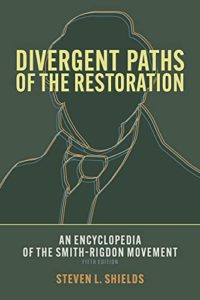Title: Divergent Paths of the Restoration: An Encyclopedia of the Smith-Rigdon Movement (Fifth Edition)
Author: Stephen L. Shields
Publisher: Signature Books
Genre: Religious History
Year Published: 2021
Number of Pages: 1121
Binding: e-book only
ISBN13: 978-1-56085-401-2
Price: $9.99
Reviewed by Conor Hilton for the Association for Mormon Letters
Divergent Paths of the Restoration: An Encyclopedia of the Smith-Rigdon Movement (Fifth Edition) is a remarkable book. I am not familiar with the earlier editions, so cannot speak to what may differ about this latest one, but I am confident that there’s much of value here for those curious about the ‘Smith-Rigdon Movement’. Stephen L. Shields demonstrates a sweeping familiarity with countless ‘expressions’ of the Smith-Rigdon Movement. Other reviews here have offered an insightful overview of the volume and some discussion of how it is structured (you can read a couple here and here).
Rather than retrace the ground covered by these reviews, I thought I would offer some thoughts on a few different uses for this volume, to give prospective readers a sense of why you want to have access to this fascinating resource.
- General Resource
The first, and most obvious, is as a general resource for folks interested in Mormonism, or the Smith-Rigdon Movement as Shields refers to it. The book contains a wealth of information that can be helpful for anyone who follows updates in Mormonism, whether that’s in current events, Mormon studies, or otherwise. If you ever encounter a reference to a figure or expression of Mormonism that you are unfamiliar with, having Shields’ encyclopedia on hand would be quite valuable. I have consulted it a handful of times already in the few months I have had a copy, looking for more information on various expressions of the Smith-Rigdon Movement that came up in conversations with friends and family.
- Church History Study Companion
The second use of the encyclopedia that I see is as a companion for the study of church history. No matter what period of church history you are studying, the encyclopedia offers insight into how the Smith-Rigdon Movement evolves and shifts, providing an easy way to track what different historical figures do after their place in the ‘traditional’ narrative as I was taught it. I wish I had had this book as a resource last year as I was reading through SAINTS and studying the Doctrine & Covenants. Regardless, I am glad to have the book now as I go about future study, with the encyclopedia offering a small taste of the variety in expressions of the Smith-Rigdon Movement.
- Artistic Inspiration
And that leads to the third and final use of Shields’ work that I wanted to mention—as an artistic inspiration. Since this is a review featured on the Association of Mormon Letters’ blog, I thought it would useful to point out a possible value for speculative fiction writers. One of the things that I have realized in my own, relatively brief, perusal of the encyclopedia is the variety and wealth of differences in these many expressions of the Smith-Rigdon Movement. For anyone who writes speculative Mormon fiction, particularly those writers interested in imagining alternative histories and futures of Mormonism, the variety of the expressions that Shields highlights is instructive, and begging to be mined for ideas, differences, etc.
Shields’ work is remarkable and valuable in a variety of different ways. Highly recommend it!

